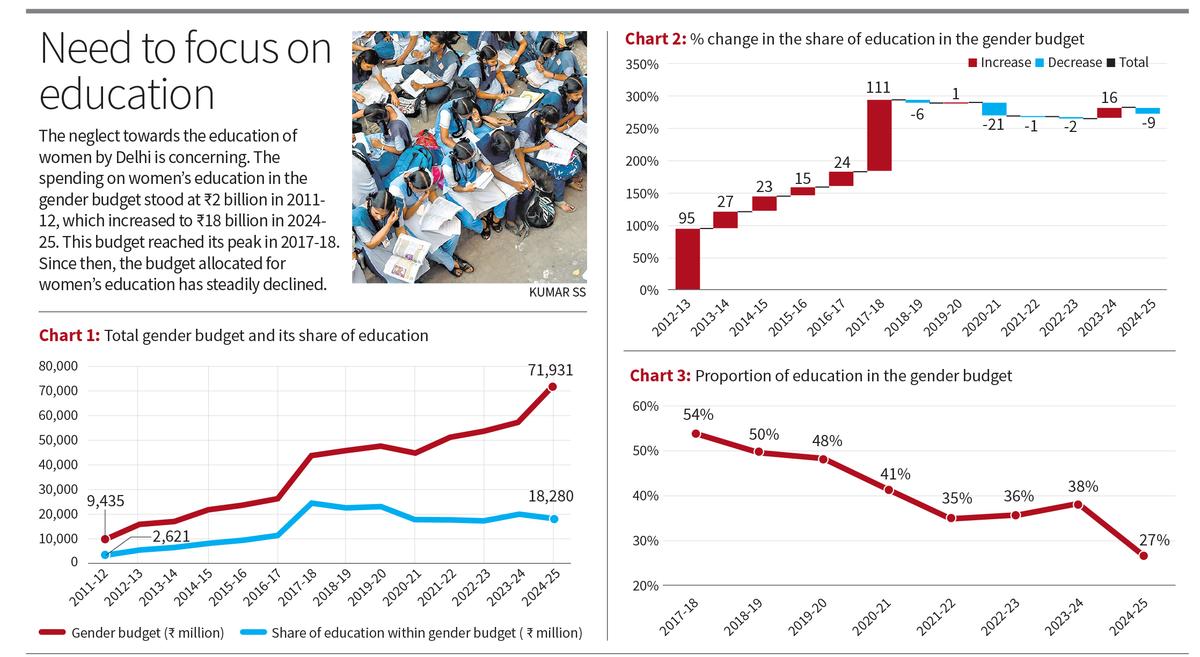
Students celebrating their success after the announcement of the CBSE class 10th exam results, on May 12, 2023.
| Photo Credit: SHIV KUMAR PUSHPAKAR
There are 71 lakh women voters in Delhi, which is nearly half of the total electorate. Further, women have a high turnout rate as well. So, it is no surprise that all contesting parties provide incentives tailored towards women. These incentives then come to light through the budget. Over the last decade, the overall budget for Delhi has increased from ₹271 billion to ₹760 billion. But, how much of this budget is reserved for women?
Investing in women
Overall, the gender budget of Delhi has witnessed a seven-fold increase from ₹10 billion in 2011-12 to ₹71 billion in 2024-25 (Figure 1). While providing financial assistance to women and child development is essential to reduce the gender gap, it is equally important to invest in other components like, education and health. Investments in education have multiplier effects and lead to long term benefits by generating a highly literate and skilled workforce for the country. Education of women, particularly, can bridge the gender gap in employment and achieve wage parity. What is needed is not freebies but concrete steps that can enable systematic growth in the economic and social empowerment of women.

The neglect towards the education of women by Delhi is concerning. The spending on women’s education in the gender budget stood at ₹2 billion in 2011-12, which increased to ₹18 billion in 2024-25. This budget reached its peak in 2017-18 touching ₹24 billion. Since then, the budget allocated for women’s education has steadily declined. For the last five years, the education budget has reported a negative growth, with exceptions for 2019-20 and 2023-24 (Figure 2). Another surprising fact is that the education budget made up 54% of the gender budget in 2017-18, but steadily declined to a mere 27% in 2024-25 (Figure 3). Concerningly, there was a massive decline of 9% in the education budget in just the past one year. The decrease is not just in the share, but also in the amount allocated to education (see figure 1), indicating that cash transfers and freebies have become the focus of gender budgets.
Priority for women’s education
Education and technical training are major pillars for sustainable long-term growth. A lack of investment in the education sector can have negative spillovers into the labour market. According to the Periodic Labour Force Survey (PLFS, 2023-24), compared to the national average of 45.2%, Delhi’s female labour force participation stands at 21%, the lowest in India. While most people in Delhi hold regular salaried jobs according to PLFS (2023-24), most women are working as house helps or cleaners, and men as shopkeepers or salespeople. Clearly, women are working in the lowest end of the skill spectrum. These jobs offer poor pay and low standard of living. Thus, low investments in female education lead to a relatively smaller female workforce, lower skill levels and low paying jobs. Secondly, the lack of a skilled women workforce can also lead to high gender inequalities in the labour force. As of 2023-24, the gender gap in labour force participation for Delhi stands at 51.6 percentage points. Moreover, the gender gap in top roles — legislators, senior managers, and CEOs — is stark, with 94% of these positions being held by men. Women are also under-represented in high skilled jobs, such as technicians and associate professionals. Only 3.8% of the female labour force are in these jobs compared to 10.34% of the male labour force. This points to the fact that investments in education are needed to bridge the gap in the high skilled workforce.
Third, the lack of technical and professional education of women has led to the concentration of women in certain fields. Most women professionals are in the teaching and health sector. It is crucial, therefore, to promote technical education training and professional courses among women to close the gender gaps in various sectors.
Cash transfers are necessary for relief but for empowerment of women, education and training are of utmost importance. Improving the budget for women’s education would greatly reduce the gap in the long run.
The writers are with ICRIER, an economic think tank based in Delhi. The views expressed are personal.
Published – February 04, 2025 08:30 am IST
